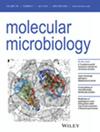Role of the Multicopper Oxidase CueO in Copper Homeostasis Under Anaerobic Conditions in Enterobacteria
IF 2.6
2区 生物学
Q3 BIOCHEMISTRY & MOLECULAR BIOLOGY
引用次数: 0
Abstract
The periplasmic multicopper oxidase CueO plays a crucial role in copper detoxification in enterobacteria. CueO contains a catalytic site, the Cu‐T1 center, and a methionine‐rich (Met‐rich) domain capable of binding copper. This enzyme oxidizes cuprous ions (Cu多铜氧化酶CueO在肠杆菌厌氧条件下铜稳态中的作用
质周多铜氧化酶CueO在肠杆菌的铜解毒中起着至关重要的作用。CueO含有一个催化位点、Cu - T1中心和一个能够结合铜的富蛋氨酸(Met - rich)结构域。这种酶将铜离子(Cu+)氧化为毒性较小的铜离子(Cu2+),并伴有氧还原。这种氧依赖性已经确定了CueO在好氧条件下减轻铜胁迫的作用,但其在厌氧环境中的功能仍不确定。在本研究中,我们证明了大肠杆菌和鼠伤寒沙门氏菌在厌氧条件和铜胁迫下产生CueO,并通过其催化活性促进铜的稳态。通过使用催化位点突变或富Met结构域缺失的CueO变体,我们发现CueO的催化活性,而不是其铜结合能力,对铜抗性至关重要。此外,我们发现,在大肠杆菌中删除其他铜稳态系统,即内膜转运体CopA和外排泵CusCBA,会导致厌氧条件下CueO的过量产生。这种生产过剩增强了∆copA∆cusB菌株的抗铜能力。总的来说,我们的研究结果为厌氧条件下CueO在铜解毒中的作用提供了证据,强调了它在这种环境中的重要性,即宿主-病原体相互作用或生物膜的形成。
本文章由计算机程序翻译,如有差异,请以英文原文为准。
求助全文
约1分钟内获得全文
求助全文
来源期刊

Molecular Microbiology
生物-生化与分子生物学
CiteScore
7.20
自引率
5.60%
发文量
132
审稿时长
1.7 months
期刊介绍:
Molecular Microbiology, the leading primary journal in the microbial sciences, publishes molecular studies of Bacteria, Archaea, eukaryotic microorganisms, and their viruses.
Research papers should lead to a deeper understanding of the molecular principles underlying basic physiological processes or mechanisms. Appropriate topics include gene expression and regulation, pathogenicity and virulence, physiology and metabolism, synthesis of macromolecules (proteins, nucleic acids, lipids, polysaccharides, etc), cell biology and subcellular organization, membrane biogenesis and function, traffic and transport, cell-cell communication and signalling pathways, evolution and gene transfer. Articles focused on host responses (cellular or immunological) to pathogens or on microbial ecology should be directed to our sister journals Cellular Microbiology and Environmental Microbiology, respectively.
 求助内容:
求助内容: 应助结果提醒方式:
应助结果提醒方式:


